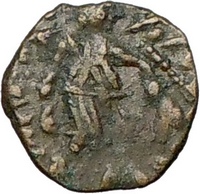Johannes Roman Usurper 423-425AD Biography Ancient Coins Numismatic
Investment
Buy certified authentic coins of
Johannes - Roman Usurper
Enjoy incredible value as every coin purchased here comes with it's own,
signed, custom-made certificate of authenticity, a $50-$100 value,
absolutely free! Check it out today.


Example of Authentic Ancient
Coin of:
Johannes - Roman Usurper: 423-425 A.D. -
Bronze AE4 Rome mint: 423-425 A.D.
Reference: RIC 1916
D N IOHANN-ES P F AVG, Diademed, draped and cuirassed bust right.
SALVS REI-PVBLICE Chi-Rho/Є/RM,
Victory advancing left, holding trophy over right shoulder, dragging
captive with left hand
The Chi Rho is one of the earliest
christograms used by Christians. It is
formed by superimposing the first two letters in the Greek spelling of
the word
Christ (
Greek : "Χριστός" ), chi = ch and rho =
r, in such a way to produce the
monogram ☧. The Chi-Rho
symbol was also used by pagan Greek scribes to mark, in the margin, a
particularly valuable or relevant passage; the combined letters Chi and
Rho standing for chrēston, meaning "good."
Although not technically a cross, the Chi Rho invokes the crucifixion
of Jesus as well as symbolizing his status as the Christ. There is early
evidence of the Chi Rho symbol on Christian Rings of the third century.
Ioannes, known in English as Joannes,
was a
Roman usurper (423-425) against
Valentinian III.
On the death of the Emperor
Honorius (August 27, 423),
Theodosius II, the remaining ruler of
the
House of Theodosius hesitated in
announcing his uncle's death. In the interregnum, Honorius's
patrician at the time of his death,
Castinus, elevated Joannes as emperor.
Joannes was a
primicerius notariorum or senior
civil servant at the time of his elevation.
Procopius praised his mildness,
intelligence, and general ability. Unlike the Theodosian emperors, he
tolerated all
Christian sects. His control over Gaul
was insecure: his pretorian prefect of that region was slain at Arles in
an uprising of the soldiery there. And
Comes
Bonifacius, in control of the
African provinces, held back the grain
fleet from
Rome.
Joannes had hoped that he could come to an agreement
with the emperor Theodosius, but when
Theodosius II elevated the young
Valentinian III first to
Caesar, then to co-emperor as an
Augustus (undoubtedly influenced by
Valentinian's mother
Galla Placidia), he knew he could only
expect war. Late in 424, he sent one of his younger, but promising,
followers
Aëtius on an embassy to the
Huns to seek military help.
While Aëtius was away on his mission, the army of the
Eastern Empire left
Thessalonica for
Italy, and soon made their base in
Aquileia. Further military actions were
inconclusive until the garrison of
Ravenna was convinced to betray him to
a force led by
Aspar, the son of the Eastern
commander. The fallen emperor was brought to Aquileia where first his
hand was cut off, then he was paraded on a donkey in the Hippodrome to
the insults of the populace, then after further insults and injuries he
was decapitated in June or July of 425.
Three days after Joannes's death, Aëtius returned at
the head of a substantial Hunnic army. After some skirmishing, Placidia
and Aëtius came to an agreement that established the political landscape
of the
Western Roman Empire for the next
thirty years. The Huns were paid off and sent home, while Aetius
received the position of
magister militum (commander-in-chief
of the
|